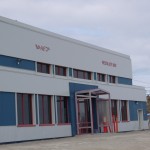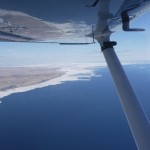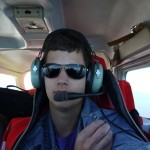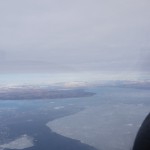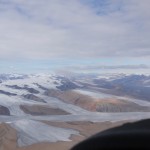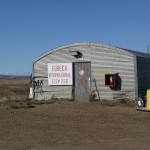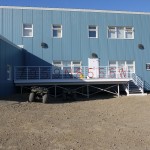Randy made me a wonderful breakfast, and Jane (the reporter) joined me on the ride to the airport. I first went to visit the meteorological forecast service people of the polar continental shelf program. I traded chips and salsa sauce for a very detailed forecast. CAVOK all the way to Eureka. I was more interested in the forecasts for the North Pole the next day. It took a while to download the satellite images of the pole. Once completed, the scientist took a thorough look, and explained that there was a high pressure ridge creating good weather, but also low clouds about 50 NM from the pole itself. The weather would be stable for about a week, but deteriorate slowly every day. I promised I would call him the next day for an update. When I would fly over the pole, I’d want to see it. So good weather was somewhat mandatory. I added a phone number to my collection to call the next day, and went to visit the radio guy.
This friendly gentleman, a local inuit, took care of the plane during the “night”, and turned it with the nose in the wind, since apparently it started bouncing away when the wind picked up. Many thanks sir! Next on the todo-list was the fueling of the plane. This time it took only one barrel to fill up the airplane. I described the fueling process to Jane and managed not to cut all my fingers this time. One hour later, the plane was ready to fly, a flight plan was filed, and I tried on my brand new immersion suit. It was easy to get into, but once I was wearing it, I felt like an oversized Teletubby.
I tried to enter the plane. This was already a difficult task in my normal clothes, let alone in a fat, thick rubber suit. After a few tries, the easiest way was too swing my feet across the ceiling and install myself on the seat while trying to avoid breaking the yoke. I tried to keep the question “how will you exit the airplane in case of a real ditching” out of my head and comforted myself with the knowledge that at least I would drown all warm and comfortable.
I waved the people gathering around Jane goodbye and started the engine with a very low throttle setting. To avoid gravel damage, I did not use the brakes and let the airplane roll by itself while the engine was idling. A Kenn Borek Air Twin Otter took off before me. While backtracking on the runway, I performed the necessary run-up items. All looked well. The airplane was ready for its flight to one of the most remote airports in Canada. Full throttle brought the airplane up to speed. I pulled the nose up and set course for Eureka (CYEU). Ten minutes later, every sign of a civilization was gone again. I left Cornwall (the island on which Resolute Bay was located) behind me, crossed some water, flew over some other islands and so on. Some of the water was just that: water, but most of the time, a thin layer of melting ice was still visible, which created some nice patterns in the water. Under influence of the wind, this ice was sometimes drifted against a coast line which, as I would learn later, decreases the temperature drastically.
Only one hour of flying to go, and my map was telling me to expect mountains up to 5000ft. And indeed, first as tiny anthills, later as huge solid rocks, the mountains grew bigger. What was first a little dot on the horizon soon grew into a huge glacier below the wheels of my little plane. Although the absolute height of the mountains was not that high, having the base of the mountain at sea level did show an impressive height difference. I hopped from top to top, trying not to confuse all these valleys (thank you GPS!). I enjoyed the mountain view for 45 minutes. As sudden as they appeared, they shrunk again, only to make room for the final water crossing of this trip: the bay where Eureka was located.
I tuned in on the Eureka frequency, and received a response almost immediately. This was very strange for an airport that received maybe 2 flights a day. I made a wonderful approach over the water and saw the gravel runway between all the other gravel that covered almost every square inch. After the smooth landing, I was told that I could park anywhere. After I parked and shut down my engine, the scientist in charge came to greet me, and, told me to move the plane to the other side of the runway, where they stored their fuel. Aziz made arrangements so I could use a drum of fuel. It took me just under 45 minutes to partially refuel my tanks. I saved the remaining fuel in the drum for my flight back.
The scientist in charge drove me over to the weather station (about 2 km west of the airport). There I found out that the ATC frequency was broadcasted in the recreation room, which explained the rather quick response earlier. I informed the people there of my plans, and asked for a weather forecast for the day after (it was after all a weather station). I was very surprised to hear that they couldn’t help me with that. The weather station only measures data, it does not give out forecasts. That meant I would have to call my new friend at the PCSP (Polar Continental Shelf Project), located 350 NM more south, to get a forecast for the North Pole.
I walked around a bit, and learned that there are normally 9 “permanent” residents. They live in Eureka for 3 months, then go home for 3 months and are replaced by other people. During summer, the population is increased to 15 with extra scientist, flying around in helicopters all around the area. The military itself also had a base there. As a matter of fact, one of my “followers” on the AvCanada forum called the military over there, to ask if there was a C172 on the ramp. So I dropped by and said hi to the station commander. He called me nuts when I informed him about my plan, but also had a bit of respect for it. I also met Massimo, an Italian helicopter pilot who moved to Canada. He was very interested and was curious to see if it would work out. He was already impressed by me reaching Eureka in a single engine airplane.
With all this support and interest in my trip, I went to bed feeling all warm and fuzzy inside. And yet, a little nagging feeling of fear and doubt was sneaking its way into my head. Against all odds, I made it to 80°N in this very unforgiving terrain. I had lots of luck so far that nothing serious broke down, and that the technical problems were discovered before they caused any serious harm. I was lucky to have met such nice people with only good intentions. People who kept their promises, who came through for me in the end. I had been flying for only 2 weeks and was about to reach my goal the next day, or fail miserably in an even more remote area. And what about flying for 12 hours, would I be able to handle it ? Would the plane be able to handle it ? And the ferry tank ? All these thoughts were spinning in my head. I somehow managed to fall asleep. I had confusing and stressful dreams that night.
- Resolute Bay airport building
- Crossing another creek/river/lake/passage
- Using an immersion suit to keep me warm, fighting the cold and trying to keep up my energy.
- More and more ice, mountains far away
- Crossing the smaller mountains, enjoying the view of the glaciers
- Bigger mountains, bigger glaciers
- Eureka in sight!
- Eureka international airport
- Almost at 80°N
- Goodnight Eureka. See you tomorrow!
